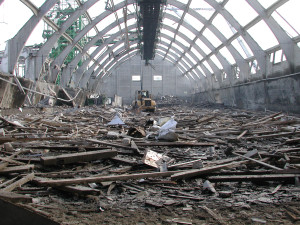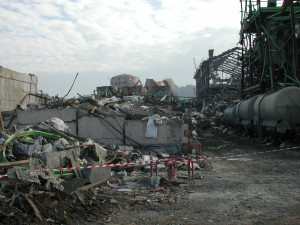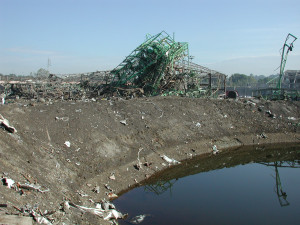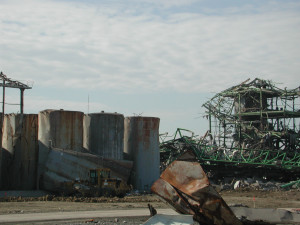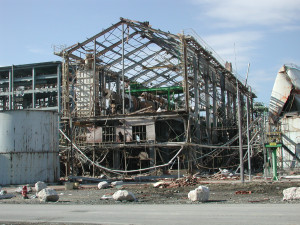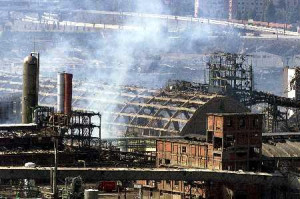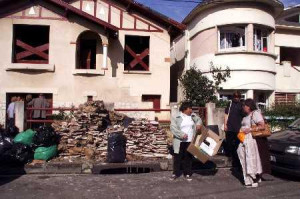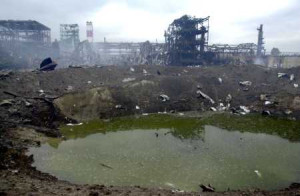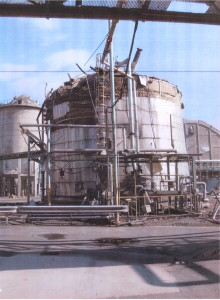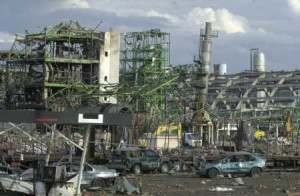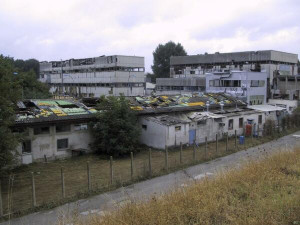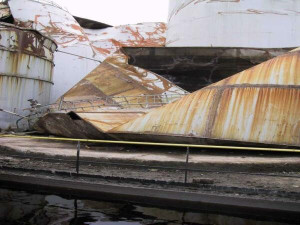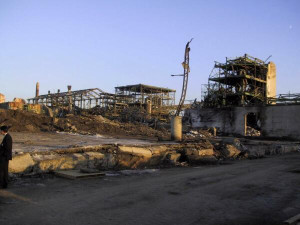A phenomenon of exceptional violence
Between 20 and 120 tonnes of a stock containing more than 300 tonnes of ammonium nitrate refuse detonated in a fertiliser plant. The causes and circumstances surrounding the accident would give rise to several investigations and expert appraisals during the following months. Over a 250-m² floor area, the depot formed a band 25 m long, 8 to 10 m wide and 2 to 4 m high. The explosion, corresponding to a 3.4 magnitude earthquake on the Richter scale, could be noticed up to 75 km away. Its intensity was evaluated as equivalent to 20-40 tonnes of TNT.
Disastrous consequences
At the time of the explosion, 266 plant employees and 100 subcontractors were working onsite. 31 deaths are recorded:
- 21 deaths occurred at the facility. Five of the casualties were working for subcontractors and 5 others were performing a range of onsite activities (delivery, elevator repair, etc.) or just passing by
- 1 was assigned to the neighbouring site
- 9 were located outside the facility, all of whom were killed either immediately by the explosion or over the following days.
Moreover, hundreds of serious injuries were reported, of which 300 victims remained in hospital for over 6 days. On the whole, thousands of people in the vicinity would require hospitalisation. On October 17th, 2001, the Haute-Garonne Prefecture tallied a total of 2,442 individuals affected by the accident. Property damage to the plant was considerable: an oval crater 65 m long, 45 m wide and 7 m deep occupied the spot where the depot once stood; 80 ha of the plant were largely devastated. This facility and 5 nearby chemical sites also affected by the accident were required to suspend activities and ensure safety at their respective locations, by disposing over the course of a few months their inventories of hazardous products; 1,300 other firms, combining industries, retail businesses and the building trades, affected to varying degrees (accounting for a total workforce of 21,000) were gradually inventoried over the subsequent weeks. Within a 3-km radius, 26,000 dwelling units were damaged, including 11,200 seriously, and more than 1,200 families had to be relocated. Insurance companies assessed overall property damage at between €1.5 and €2.3 billion. Tens of victims whose blown-out windows at their homes had still not been replaced would be exposed to cold winter weather several months hence. Between October 17th and 19th, several tonnes of ammoniated solution significantly polluted the Garonne killing 8,000 pieces of fish. In July 2006, more than 750,000 m³ of ground had been excavated for treatment; the works ended at the beginning of 2008. The costs of dismantling and decontamination of the site are evaluated at 100 M€.
The unforeseen developments of the judicial action…
The civil trial took place between February 23 and June 30, 2009 with a significant technical support and was entirely filmed for the first time in French history. The court required a 225,000 Euros fine against the group and 45,000 Euros fine plus a three year suspensive imprisonment order against the manager. The criminal court of Toulouse pronounced the discharge of the accused who were given the benefit of the doubt, leading to strong reactions from victims’ associations. A new trial (appeal) begun on November 3rd, 2011 in Toulouse. The Court of Appeal pronounced its verdict on September 24th, 2012, recognizing the company and its former director guilty of involuntary homicide and injuries due to “clumsiness, carelessness, negligence, recklessness or breach of a duty of safety.” The fines were confirmed, as well as the prison sentences : 2 years with suspension and one year with partial release. However, the Court considered once again the prosecution against the group and its former CEO as “inadmissible”. The defense lodged an appeal (to the cassation court) 3 days after the verdict was known.
On January 13th, 2015, the Cassation Court cancelled the decision of the Court of Appeal by invoking the impartiality of one of the magistrates of that jurisdiction. This decision raised the indignation of victims’ associations. The new appeal trial will be held in Paris in January 2017.
… and of the administrative action
In September 2010, the Administrative Court of Toulouse dismissed 3 persons who wanted to involve the responsibility of the State. In its judgment of 24 January 2013, the Administrative Court of Appeal of Bordeaux acknowledged partial responsibility of the State and allocated 1,250 euros in damages to each of the 3 complainants. The State lodged an appeal. On December 17th, 2014, the Council of State cancelled the judgment of the Administrative Court of Bordeaux, judging that the State is not at fault.
Download the detailed report in .pdf format (1.6 Mb)



